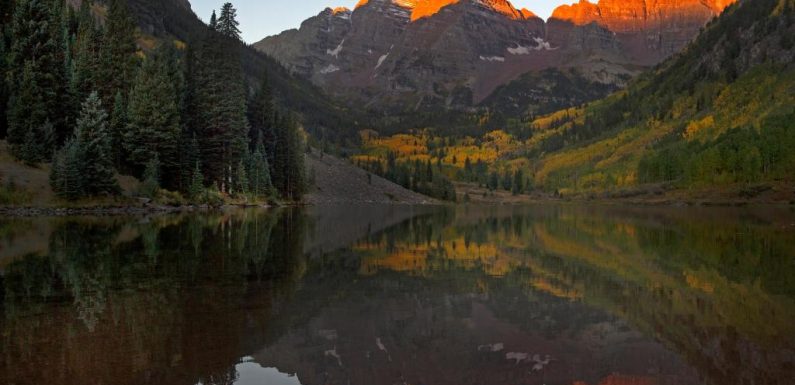
The shuttle bus buzzed with excitement as we approached the trailhead. You could see it on the hikers’ wide-eyed faces, which lit up when the jagged, snow-dusted Pyramid Peak and Maroon Bells appeared through the windshield.
The Maroon Bells-Snowmass Wilderness, a 181,535-acre chunk of the Elk Mountains in White River National Forest, is a veritable playground for hikers. All trail styles, effort levels and lengths are available here: out-and-backs, loops, lollipops and even thru-hikes to other towns.
Originally, we planned to hike the West Maroon Trail from Aspen to Crested Butte, a fabled 12-mile trek over 12,500-foot West Maroon Pass. We’d spend the night in Crested Butte and then hike by on the same trail the next day. We changed our plans after running into challenges arranging shuttles and lodging. Instead, we decided to use Aspen as a base for a couple of epic day hikes, starting with a 12-mile out-and-back quest on West Maroon — at the peak of fall foliage.
As my group of five gathered at the trailhead, adjusting our trekking poles and drinking tubes and checking route-tracking apps, other hikers passed by. There were folks in flip-flops headed to the paved path to Maroon Lake as well as trail runners and backpackers tackling the Four-Pass Loop (a 28-mile legendary trail). We day hikers stood in the middle — literally and figuratively — wondering how far we’d make it on West Maroon Trail before having to turn around to make sure we caught the final shuttle back to Aspen Highlands at 5 p.m.
The West Maroon Trail takes you to Crater Lake and then continues up a long glacial valley where you slowly ascend over the rocky moraine, through willows and then tundra to the 12,500-foot pass. I’d been looking forward to the “town to town” aspect of our hike; it made me think of trekking between villages in the Himalayas or Alps, or along the Camino de Santiago in Spain. I’ve heard tales of these hikes, and was eager to try a similar opportunity in Colorado, a few hours’ drive from my home. I once hiked from Littleton to Breckenridge along the Colorado Trail and I remember appreciating the linear nature of going as far as you can each day, stopping only to eat and maybe soak your feet before setting up camp to sleep somewhere near the trail, and then waking up to do it all over again.
But as we stepped through flaming-yellow aspen groves above Maroon Lake, I also appreciated just being there, on that trail, in that exact moment. It didn’t matter where we were headed. My friend Nathan Dolenc, who thru-hiked the 485-mile Colorado Trail from Denver to Durango in 2020, agreed.
“It’s about the accomplishment,” he said, not the number of miles or the end destination. “If there’s a peak or a pass to climb, then an out-and-back and a linear thru-hike can be quite similar.”
For me, the accomplishment was just getting out there and enjoying the colors and crisp air of fall in Colorado. We turned around about a mile before the top of West Maroon Pass and enjoyed every step of the way. And made the second-to-last shuttle back to town.
IF YOU GO
Learn more about shuttle and parking restrictions at aspenchamber.org/plan-trip/trip-highlights/maroon-bells/reservations.
Stay: Annabelle Inn, 232 W. Main St., Aspen; 877-266-2466, annabelleinn.com. Expect to pay $280 or more, with a hiker-friendly breakfast to fuel your day.
Eat: Down the block from the Annabelle, Mi Chola (411 W. Main St., 11:30 a.m.-11 p.m. daily) has an inviting margarita menu and chicken chile verde to warm you up; 970-710-7076, aspenchola.com.
Subscribe to our weekly newsletter, The Adventurist, to get outdoors news sent straight to your inbox.
Source: Read Full Article









